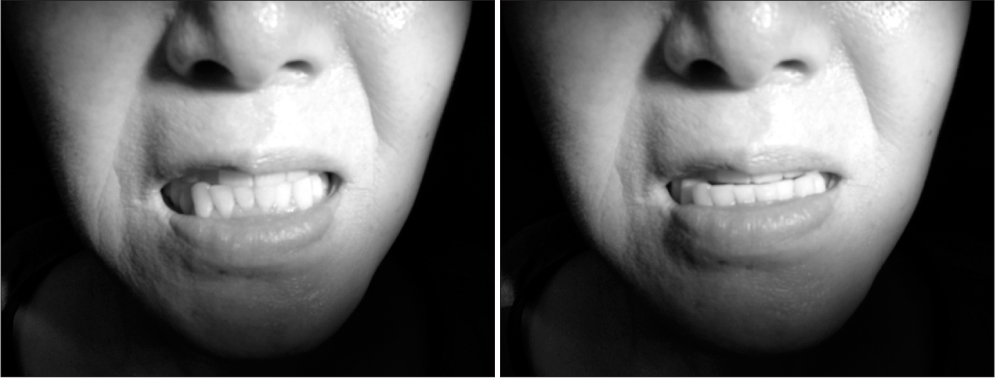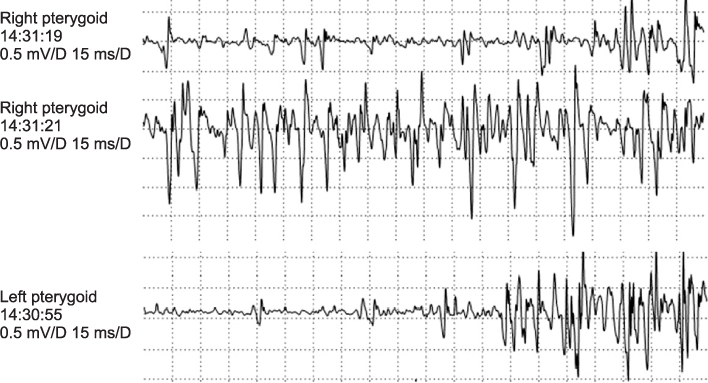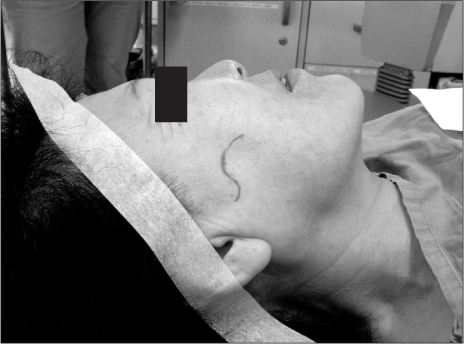J Korean Assoc Oral Maxillofac Surg.
2012 Dec;38(6):379-383. 10.5125/jkaoms.2012.38.6.379.
Oromandibular dystonia after dental treatments: a report of two cases
- Affiliations
-
- 1Department of Oral and Maxillofacial Surgery, Ulsan University Hospital, College of Medicine, Ulsan University, Ulsan, Korea. glycerol@naver.com
- 2Department of Neurology, Ulsan University Hospital, College of Medicine, Ulsan University, Ulsan, Korea.
- KMID: 2136976
- DOI: http://doi.org/10.5125/jkaoms.2012.38.6.379
Abstract
- Oromandibular dystonia (OMD) is a rare focal form of dystonia caused by prolonged muscles spasms in the mouth, face, and jaw. OMD can develop after dental treatment, as poorly aligned dentures or multiple tooth extraction may cause an impairment of proprioception in the oral cavity, leading to the subsequent development of dystonia. These repetitive involuntary jaw movements may interfere with chewing, swallowing, and speaking. We report here two cases of OMD after dental procedures.
Keyword
MeSH Terms
Figure
Reference
-
1. Scott BL. Evaluation and treatment of dystonia. South Med J. 2000. 93:746–751.
Article2. Lee KH. Oromandibular dystonia. Oral Surg Oral Med Oral Pathol Oral Radiol Endod. 2007. 104:491–496.
Article3. Thorburn DN, Lee KH. Oromandibular dystonia following dental treatment: case reports and discussion. N Z Dent J. 2009. 105:18–21.4. Maestre-Ferrín L, Burguera JA, Peñarrocha-Diago M, Peñarrocha-Diago M. Oromandibular dystonia: a dental approach. Med Oral Patol Oral Cir Bucal. 2010. 15:e25–e27.5. Marsden CD. Blepharospasm-oromandibular dystonia syndrome (Brueghel's syndrome). A variant of adult-onset torsion dystonia? J Neurol Neurosurg Psychiatry. 1976. 39:1204–1209.
Article6. Kumar PJ, Clark ML. Clinical medicine. 2005. 6th ed. Edinburgh: Saunders;1227.7. Heise GJ, Mullen MP. Oromandibular dystonia treated with botulinum toxin: report of case. J Oral Maxillofac Surg. 1995. 53:332–335.
Article8. Blanchet PJ, Rompré PH, Lavigne GJ, Lamarche C. Oral dyskinesia: a clinical overview. Int J Prosthodont. 2005. 18:10–19.9. Jankovic J. Etiology and differential diagnosis of blepharospasm and oromandibular dystonia. Adv Neurol. 1988. 49:103–116.10. Clark GT. Medical management of oral motor disorders: dystonia, dyskinesia and drug-induced dystonic extrapyramidal reactions. J Calif Dent Assoc. 2006. 34:657–667.11. Kartha N. Therapeutic challenges in dystonia. Neurol Clin. 2010. 28:927–940.
Article12. Jankovic J. Treatment of dystonia. Lancet Neurol. 2006. 5:864–872.
Article13. Batla A, Stamelou M, Bhatia KP. Treatment of focal dystonia. Curr Treat Options Neurol. 2012. 14:213–229.
Article14. Nutt JG, Muenter MD, Aronson A, Kurland LT, Melton LJ 3rd. Epidemiology of focal and generalized dystonia in Rochester, Minnesota. Mov Disord. 1988. 3:188–194.
Article15. Neychev VK, Gross RE, Lehéricy S, Hess EJ, Jinnah HA. The functional neuroanatomy of dystonia. Neurobiol Dis. 2011. 42:185–201.
Article16. Hallett M. Neurophysiology of dystonia: the role of inhibition. Neurobiol Dis. 2011. 42:177–184.
Article17. Colosimo C, Suppa A, Fabbrini G, Bologna M, Berardelli A. Craniocervical dystonia: clinical and pathophysiological features. Eur J Neurol. 2010. 17:Suppl 1. 15–21.
Article18. Chidiac JJ. Oromandibular dystonia treatment following a loss of vertical dimension. Dent Update. 2011. 38:120–122.
Article19. Singer C, Papapetropoulos S. A comparison of jaw-closing and jaw-opening idiopathic oromandibular dystonia. Parkinsonism Relat Disord. 2006. 12:115–118.
Article20. Tan EK, Jankovic J. Tardive and idiopathic oromandibular dystonia: a clinical comparison. J Neurol Neurosurg Psychiatry. 2000. 68:186–190.
Article
- Full Text Links
- Actions
-
Cited
- CITED
-
- Close
- Share
- Similar articles
-
- Speech-Induced Oromandibular Dystonia
- Botulinum Toxin Injection Therapy for Lingual Dystonia: A Case Report
- Evaluation of Treatment Outcomes in Oromandibular Dystonia Using Surface Electromyography: A Case Series
- Oromandibualr Dystonia Associated with Diabetic Hyperglycemia
- Oromandibular Dystonia: Demographics and Clinical Data from 240 Patients






